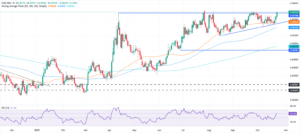The Dollar Flies Back to the Future. Forecast as of 24.10.2025

The 1970s differ from current events mainly in oil dynamics. However, US sanctions against Russia may break the downtrend in Brent and WTI and force the Fed to pause its rate-cutting cycle. Let’s explore this and make a trading plan for EURUSD.
The article covers the following subjects:
Major Takeaways
- Rising oil prices derail the Fed’s plans.
- The US economy continues to expand.
- The Fed doesn’t want to repeat history.
- EURUSD positions depend on inflation.
Fundamental Forecast for Dollar for Today
It’s not the September inflation report investors should fear — it’s the Fed’s October meeting. The central bank may turn out to be much more hawkish than markets think. Investors see it as a kind of friendly Uncle Sam who rolled up his sleeves to save a cooling labor market, ignoring inflation. But US sanctions against Russia could turn everything upside down, just as they already did with EURUSD.
To cut rates while consumer prices remain high, one condition must be met: inflation expectations must be firmly anchored. Then the CPI surge caused by tariffs can be considered temporary. Until late October, this was the case as the downtrend in Brent and WTI pushed gasoline prices lower, kept inflation expectations anchored, and created ideal conditions for declining Treasury yields.
US Treasury Yields vs. Oil Prices
Source: Bloomberg.
Donald Trump’s sanctions against Russia triggered the fastest oil rally since June, when the Iran–Israel conflict broke out in the Middle East. Forcing a major producer out of the market risks breaking the downtrend, and that’s a whole new story.
There’s much in common with the 1970s, when the Fed under Arthur Burns, pressured by President Richard Nixon, cut rates amid high inflation. It ended badly. Until recently, though, there was one key difference: back then, oil prices were soaring, while in 2025, before the sanctions, they had been falling. If investors are now witnessing the start of a bullish trend in Brent and WTI, they’d better fasten their seatbelts — we’re flying back to the future.
Neither Jerome Powell nor his likely successor, Christopher Waller, wants to end up in the history books like Arthur Burns. And it’s not just about oil. According to Goldman Sachs, financial conditions have been the most supportive since April 2022. The Fed’s own index shows that they could add nearly 1 percentage point to real GDP in 2026. Add to that the Atlanta Fed’s leading indicator pointing to 3.9% GDP growth in Q3 and consumer spending rising faster than inflation, and the message is clear: cutting rates amid hot inflation is not a story about “taming the inflation dragon” — it’s a way to anger it.
Trading plan for EURUSD for today
In my view, the 3.1% September CPI increase has already been priced into EURUSD. Therefore, figures close to the forecast are likely to make traders close their short positions, making long positions toward 1.17 relevant. But if inflation accelerates faster than expected, investors will start doubting a December rate cut and sell the euro, targeting $1.15.
This forecast is based on the analysis of fundamental factors, including official statements from financial institutions and regulators, various geopolitical and economic developments, and statistical data. Historical market data are also considered.
Price chart of EURUSD in real time mode
The content of this article reflects the author’s opinion and does not necessarily reflect the official position of LiteFinance broker. The material published on this page is provided for informational purposes only and should not be considered as the provision of investment advice for the purposes of Directive 2014/65/EU.
According to copyright law, this article is considered intellectual property, which includes a prohibition on copying and distributing it without consent.





